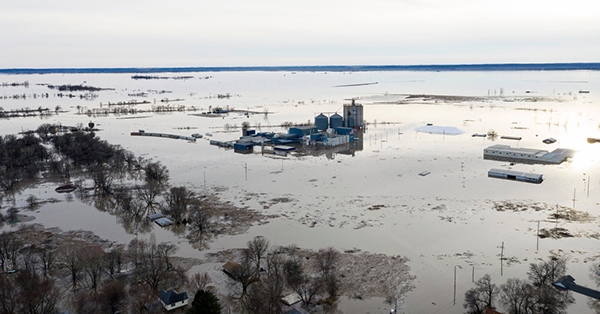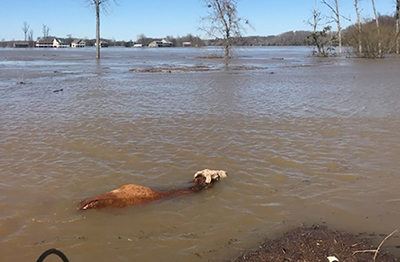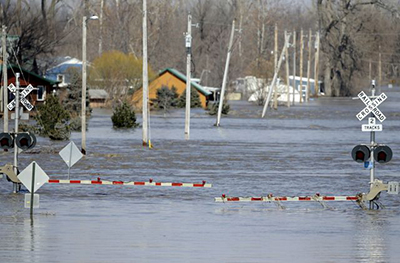Record Flooding Pummels Midwest When Farmers Can Least Afford It
By: Emily Nason
Posted on:03/20/2019 Updated:03/26/2019The record floods that have pummeled the Midwest are inflicting a devastating toll on farmers and ranchers at a moment when they can least afford it, raising fears that this natural disaster will become a breaking point for farms weighed down by already falling incomes.
LandCAN offers a variety of resources and information on emergency services. Please click on the links below to find information and assistance
Emergency Farm Loans
Emergency Assistance For Livestock Loss

Ice chunks the size of small cars ripped through barns and farmhouses. Baby calves were swept into freezing floodwaters, washing up dead along the banks of swollen rivers. Farm fields were now lakes. The record floods that have pummeled the Midwest are inflicting a devastating toll on farmers and ranchers at a moment when they can least afford it, raising fears that this natural disaster will become a breaking point for farms weighed down by falling incomes, rising bankruptcies and the fallout from new trade policies.
“When you’re losing money to start with, how do you take on extra losses?” asked Clint Pischel, 23, of Niobrara, Neb., whose lowland fields were flooded by the ice-filled Niobrara River after a dam failed. He spent Monday gathering 30 dead baby calves from his family’s ranch in this northern region of the state, finding their bodies under huge chunks of ice.
“There’s no harder business to be in,” Mr. Pischel added. “But with death and everything else, you’ve got to answer to bankers. It’s not our choice.”
In Verdigre, also in northern Nebraska, the Ruzicka family has farmed for five generations, dating back to the homesteading days of the 1800s. The farmhouse is a total loss, a prized branding iron is missing and the family’s first tractor, a 1930s model that is still used sometimes, now sits overturned in a pond of mud, its red wheel pointed to the sky.
“There’s not many farms left like this, and it’s probably over for us too, now,” said Anthony Ruzicka, whose alfalfa and corn fields were filled with giant ice chunks. “Financially, how do you recover from something like this?”
The Ruzickas were still tallying the losses to their cattle herd. They scrambled to move cows to neighboring farms before the dam burst last week, but at least 15 newborn calves perished, and they believe the death toll is much higher.
“We didn’t know what to do with them. We never, ever expected anything like this,” Mr. Ruzicka said Monday. “We just ran out of time. It was either sacrifice them or sacrifice ourselves.”

Crisis has grown all too familiar for some people in the region. In Knox County, Neb., Hannah Sucha, 25, helped coordinate efforts to deliver emergency supplies including minerals, antibiotics and salt blocks to farmers hurt by the floods. Just two years ago, Ms. Sucha said, farmers and ranchers in the area were busy donating bales of their hay to ranches in Kansas and Oklahoma devastated by wildfires.
“It’s going to affect them for years,” Ms. Sucha said. “You’re not going to be able to sleep at night because you’ve got so much loss.”
Farm experts said it was too early to quantify the full economic toll of the floods, but Steve Wellman, director of the Nebraska Department of Agriculture, said the disaster could cost the state’s livestock sector $400 million. Farm groups said it would take months or years to recover, and that residents across the region would need emergency federal aid.
“You’ve got a generation of young farmers on the verge of leaving; you’ve got a lot of mental health stress out there — and that was before the storm,” said Roger Johnson, president of the National Farmers Union. “You just pile this on top.”
As floodwaters slowly ebbed in some places on Monday, other cities, including Fargo, N.D., were getting sandbags ready and bracing for floods from rivers overflowing with snowmelt and late-winter rains. And farmers in flooded rural areas were just starting to calculate losses and consider whether they would be able to get their fields ready for spring planting.
In Holt County, Neb., Jerry Kohl, a rancher with 1,600 mature cows and 5,000 yearlings, lost dozens of cows over the past week, a loss in the hundreds of thousands of dollars. As he looked across his 30,000 acres on Monday, he saw more water than dirt.
Mr. Kohl said he had spoken by phone to more than a dozen other ranchers in the area in the past few days and concluded that the damage caused by floodwaters and the deep freeze that preceded the flooding would force a number of ranches out of business.
“I’m struggling, but there are others who have it a lot worse,” he said.
Mr. Kohl, 60, said he had not slept for more than two hours at a time in nearly a week and had not tried to leave his ranch. As much as 70 percent of the land in Holt County is flooded, he said; the roads and bridges to the south and north are washed-out. Farmers and ranchers also said they had lost miles of fences that pen in their livestock and bales of hay that feed them.
Ranchers are reluctant to acknowledge the death of their animals and blame themselves when it happens. But Mr. Kohl said he had lost about 40 calves during twin calamities of subzero cold and flooding. He said his son, two daughters and four hired workers had toiled in shifts to save as many animals as they could.

“We’re proud of raising cows and taking care of them,” he said. “We don’t like to admit to anyone we lost even one cow.”
Farmers said the losses were especially troubling because many cows were giving birth at this time of year, and the newborn calves came just as the blizzards were blowing and floodwaters were rising. Calves born under such conditions were at immediate and dire risk, Mr. Kohl said. “If you didn’t pick it up in 10 minutes, she wasn’t going to make it,” he said. “And we had all those babies out there.”
He said that each calf had to be taken by hand into one of his four heated sheds, which are large enough only for about 10 calves each.
Mr. Kohl’s focus now is on cows that are rejecting their calves because they were separated from them for as many as four days. “That’s telling her body she doesn’t need to make milk,” he said.
He said an old rancher’s trick to try to reunite mothers and their young was to rub vanilla on a cow’s nose and then liberally dose her calf with the same liquid. That mingling of the same smell, he said, often did the trick.
The future for cows without calves to care for is a bleak one.
So many calves have been lost that some ranchers have decided to cut their losses and sell them now, instead of caring for mature cows until they are pregnant again. As a result, prices have dropped precipitously, from about $1 a pound for a 1,100-pound cow to 60 cents a pound.
A cow that would have fetched $1,000 is now only worth $600.
“Everybody, me included, is going to show a loss,” Mr. Kohl said.
 Sign In
Sign In
 Sign In
Sign In
